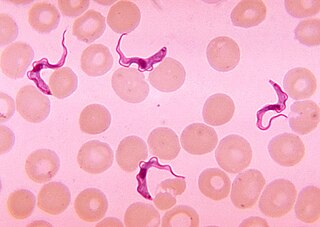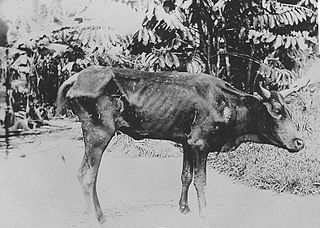Related Research Articles

Chagas disease, also known as American trypanosomiasis, is a tropical parasitic disease caused by Trypanosoma cruzi. It is spread mostly by insects in the subfamily Triatominae, known as "kissing bugs". The symptoms change over the course of the infection. In the early stage, symptoms are typically either not present or mild, and may include fever, swollen lymph nodes, headaches, or swelling at the site of the bite. After four to eight weeks, untreated individuals enter the chronic phase of disease, which in most cases does not result in further symptoms. Up to 45% of people with chronic infections develop heart disease 10–30 years after the initial illness, which can lead to heart failure. Digestive complications, including an enlarged esophagus or an enlarged colon, may also occur in up to 21% of people, and up to 10% of people may experience nerve damage.

African trypanosomiasis, also known as African sleeping sickness or simply sleeping sickness, is an insect-borne parasitic infection of humans and other animals. It is caused by the species Trypanosoma brucei. Humans are infected by two types, Trypanosoma brucei gambiense (TbG) and Trypanosoma brucei rhodesiense (TbR). TbG causes over 92% of reported cases. Both are usually transmitted by the bite of an infected tsetse fly and are most common in rural areas.

Tsetse are large, biting flies that inhabit much of tropical Africa. Tsetse flies include all the species in the genus Glossina, which are placed in their own family, Glossinidae. The tsetse is an obligate parasite, which lives by feeding on the blood of vertebrate animals. Tsetse has been extensively studied because of their role in transmitting disease. They have a pronounced economic impact in sub-Saharan Africa as the biological vectors of trypanosomes, causing human and animal trypanosomiasis.

Charles Louis Alphonse Laveran was a French physician who won the Nobel Prize in Physiology or Medicine in 1907 for his discoveries of parasitic protozoans as causative agents of infectious diseases such as malaria and trypanosomiasis. Following his father, Louis Théodore Laveran, he took up military medicine as his profession. He obtained his medical degree from University of Strasbourg in 1867.

Ethidium bromide is an intercalating agent commonly used as a fluorescent tag in molecular biology laboratories for techniques such as agarose gel electrophoresis. It is commonly abbreviated as EtBr, which is also an abbreviation for bromoethane. To avoid confusion, some laboratories have used the abbreviation EthBr for this salt. When exposed to ultraviolet light, it will fluoresce with an orange colour, intensifying almost 20-fold after binding to DNA. Under the name homidium, it has been commonly used since the 1950s in veterinary medicine to treat trypanosomiasis in cattle. The high incidence of antimicrobial resistance makes this treatment impractical in some areas, where the related isometamidium chloride is used instead. Despite its reputation as a mutagen, tests have shown it to have low mutagenicity without metabolic activation.

Trypanosomiasis or trypanosomosis is the name of several diseases in vertebrates caused by parasitic protozoan trypanosomes of the genus Trypanosoma. In humans this includes African trypanosomiasis and Chagas disease. A number of other diseases occur in other animals.

Trypanosoma is a genus of kinetoplastids, a monophyletic group of unicellular parasitic flagellate protozoa. Trypanosoma is part of the phylum Sarcomastigophora. The name is derived from the Greek trypano- (borer) and soma (body) because of their corkscrew-like motion. Most trypanosomes are heteroxenous and most are transmitted via a vector. The majority of species are transmitted by blood-feeding invertebrates, but there are different mechanisms among the varying species. Some, such as Trypanosoma equiperdum, are spread by direct contact. In an invertebrate host they are generally found in the intestine, but normally occupy the bloodstream or an intracellular environment in the vertebrate host.

Melarsoprol is an arsenic-containing medication used for the treatment of sleeping sickness. It is specifically used for second-stage disease caused by Trypanosoma brucei rhodesiense when the central nervous system is involved. For Trypanosoma brucei gambiense, eflornithine or fexinidazole is usually preferred. It is effective in about 95% of people. It is given by injection into a vein.

Diminazene is an anti-infective medication for animals that is sold under a variety of brand names. It is effective against certain protozoa such as Babesia, Trypanosoma, and Cytauxzoon. The drug may also be effective against certain bacteria including Brucella and Streptococcus.

Trypanosoma brucei is a species of parasitic kinetoplastid belonging to the genus Trypanosoma that is present in sub-Saharan Africa. Unlike other protozoan parasites that normally infect blood and tissue cells, it is exclusively extracellular and inhabits the blood plasma and body fluids. It causes deadly vector-borne diseases: African trypanosomiasis or sleeping sickness in humans, and animal trypanosomiasis or nagana in cattle and horses. It is a species complex grouped into three subspecies: T. b. brucei, T. b. gambiense and T. b. rhodesiense. The first is a parasite of non-human mammals and causes nagana, while the latter two are zoonotic infecting both humans and animals and cause African trypanosomiasis.

Trypanosoma evansi is a parasitic species of excavate trypanosome in the genus Trypanosoma that is one cause of surra in animals. Discovered by Griffith Evans in 1880 at Dera Ismail Khan, it is the first known trypanosome that causes infection. It is a common parasite in India and Iran and causes acute disease in camels and horses, and chronic disease in cattle and buffalo. In Pakistan, it has been found to be the most prevalent trypanosome species in donkeys. It is now established to infect other mammals, including humans.
Trypanosoma suis is a species of excavate trypanosome in the genus Trypanosoma that causes one form of the surra disease in animals. It infects pigs. It does not infect humans.

Animal trypanosomiasis, also known as nagana and nagana pest, or sleeping sickness, is a disease of vertebrates. The disease is caused by trypanosomes of several species in the genus Trypanosoma such as T. brucei. T. vivax causes nagana mainly in West Africa, although it has spread to South America. The trypanosomes infect the blood of the vertebrate host, causing fever, weakness, and lethargy, which lead to weight loss and anemia; in some animals the disease is fatal unless treated. The trypanosomes are transmitted by tsetse flies.

Trypanosoma cruzi is a species of parasitic euglenoids. Among the protozoa, the trypanosomes characteristically bore tissue in another organism and feed on blood (primarily) and also lymph. This behaviour causes disease or the likelihood of disease that varies with the organism: Chagas disease in humans, dourine and surra in horses, and a brucellosis-like disease in cattle. Parasites need a host body and the haematophagous insect triatomine is the major vector in accord with a mechanism of infection. The triatomine likes the nests of vertebrate animals for shelter, where it bites and sucks blood for food. Individual triatomines infected with protozoa from other contact with animals transmit trypanosomes when the triatomine deposits its faeces on the host's skin surface and then bites. Penetration of the infected faeces is further facilitated by the scratching of the bite area by the human or animal host.

Trypanosoma congolense is a species of trypanosomes and is the major pathogen responsible for the disease nagana in cattle and other animals including sheep, pigs, goats, horses and camels, dogs, as well as laboratory mice. It is the most common cause of nagana in east Africa, but is also a major cause of nagana in west Africa. This parasite is spread by tsetse flies. In its mammalian host, Trypanosoma congolense only lives in blood vessels, and causes in particular anaemia.

Isometamidium chloride is a triazene trypanocidal agent used in veterinary medicine.
A Trypanosomiasis vaccine is a vaccine against trypanosomiasis. No effective vaccine currently exists, but development of a vaccine is the subject of current research.
Wendy Gibson is Professor of Protozoology at University of Bristol, specialising in trypanosomes and molecular parasitology.
Fexinidazole is a medication used to treat African trypanosomiasis caused by Trypanosoma brucei gambiense. It is effective against both first and second stage disease. Some evidence also supports its use in Chagas disease. It is taken by mouth.
A trypanotolerant organism is one which is relatively less affected by trypanosome infestation.
References
- ↑ Trypanocidal+Agents at the U.S. National Library of Medicine Medical Subject Headings (MeSH)
- ↑ MeSH list of agents 82014344
- ↑ GOBLE, F. C. (January 1950). "Chemotherapy of experimental trypanosomiasis; trypanocidal activity of certain bis (2-methyl-4-amino-6-quinolyl) amides and ethers". Journal of Pharmacology and Experimental Therapeutics . 98 (1): 49–61. PMID 15403620.
- ↑ Delespaux, Vincent; Geysen, Dirk; Van den Bossche, Peter; Geerts, Stanny (2008). "Molecular tools for the rapid detection of drug resistance in animal trypanosomes". Trends in Parasitology . Elsevier BV. 24 (5): 236–242. doi:10.1016/j.pt.2008.02.006. hdl: 2263/8861 . ISSN 1471-4922. PMID 18420457.
- 1 2 Chitanga, Simbarashe; Marcotty, Tanguy; Namangala, Boniface; Van den Bossche, Peter; Van Den Abbeele, Jan; Delespaux, Vincent (2011-12-20). Keiser, Jennifer (ed.). "High Prevalence of Drug Resistance in Animal Trypanosomes without a History of Drug Exposure". PLOS Neglected Tropical Diseases . Public Library of Science (PLoS). 5 (12): e1454. doi: 10.1371/journal.pntd.0001454 . ISSN 1935-2735. PMC 3243716 . PMID 22206039.
- ↑ Mamoudou, A.; Delespaux, V.; Chepnda, V.; Hachimou, Z.; Andrikaye, J.P.; Zoli, A.; Geerts, S. (2008). "Assessment of the occurrence of trypanocidal drug resistance in trypanosomes of naturally infected cattle in the Adamaoua region of Cameroon using the standard mouse test and molecular tools". Acta Tropica . Elsevier BV. 106 (2): 115–118. doi:10.1016/j.actatropica.2008.02.003. ISSN 0001-706X. PMID 18355771.
- ↑ Mungube, Erick O; Vitouley, Hervé S; Allegye-Cudjoe, Emmanuel; Diall, Oumar; Boucoum, Zakaria; Diarra, Boucader; Sanogo, Yousouf; Randolph, Thomas; Bauer, Burkhard; Zessin, Karl-Hans; Clausen, Peter-Henning (2012). "Detection of multiple drug-resistant Trypanosoma congolense populations in village cattle of south-east Mali". Parasites & Vectors . Springer Science and Business Media LLC. 5 (1): 155. doi: 10.1186/1756-3305-5-155 . ISSN 1756-3305. PMC 3432589 . PMID 22852796.
- 1 2 Mulugeta, Wubet; Wilkes, Jon; Mulatu, Woudyalew; Majiwa, Phelix A.O; Masake, Rachael; Peregrine, Andrew S (1997). "Long-term occurrence of Trypanosoma congolense resistant to diminazene, isometamidium and homidium in cattle at Ghibe, Ethiopia". Acta Tropica . Elsevier BV. 64 (3–4): 205–217. doi:10.1016/s0001-706x(96)00645-6. ISSN 0001-706X. PMID 9107367. S2CID 23878484.